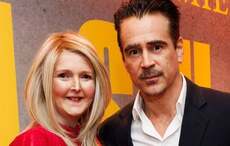Certain to passionately divide the critics when it opens on Friday, director Baz Luhrmann’s opulent vision of 'The Great Gatsby' brings Irish American writer F. Scott Fitzgerald’s classic novel to the big screen, this time in 3D.
Irish people who flock to the cinema this week to see 'The Great Gatsby,' one of the most anticipated films of the summer, may just leave the theater with a better sense of the greatness of this lyrical tale of excess and doomed love than almost any other audience.
The reason for that is because the film, made in eye-popping 3D, is an evocative portrait of a fast-talking nobody without wealth or connections who still somehow manages to rise to the center of New York society in the Jazz Age. Gatsby’s rise turns out to have quite a lot to say about the rise of the Irish in America.
F. Scott Fitzgerald, the Irish American writer who had already made his name by the time his greatest book was published in 1925, knew all about the tensions that could arise when Irish Catholics (and every other socially disfavored group) tried to claim their share of the American Dream.
Sometimes the pushback was subtle -- by refusing you entry into an upscale gentleman’s club, say -- but sometimes it came with a raised fist. The message was always the same -- you don’t belong here. Both of these faces of discrimination, one genteel the other violent, add period authenticity to director Baz Luhrmann’s opulent new film.
Born in 1896 in St. Paul, Minnesota to an upper middle class Irish American family, Fitzgerald’s mother Mary McQuillan was from an Irish Catholic family that had made a small fortune in Minnesota as wholesale grocers.
His father Edward Fitzgerald opened a wicker furniture business in St. Paul and thereafter worked as a salesman based out of New York, but in the end the family turned away from their nomadic lifestyle and returned to St. Paul to live comfortably off his mother’s fortune.
Fitzgerald’s rise to literary stardom was rapid and one of the most assured of any great American writer. Bright, handsome and ambitious, he cut a figure even in his teenage years where his talent was first noticed at the Newman School, the prestigious Catholic prep school in New Jersey.
Later Fitzgerald studied at Princeton University before dropping out in 1917 to enlist in the U.S. Army. Fear that he might die in World War I saw him complete his first novel weeks before reporting for duty.
Many of these straight from the elements eventually made their way into The Great Gatsby in a new fictional form, but there’s more to Fitzgerald’s vision than simply recreating the defining experiences of his young life. His appetite for life, which was insatiable, was matched by his ambition, which was all consuming.
Published in 1925 when Fitzgerald was 28, 'The Great Gatsby' is narrated by the lovelorn Nick Carraway, a bright eyed Midwesterner whose fateful decision to move to the fictional town of West Egg on Long Island ends up dramatically altering his life.
Next door to Carraway’s cottage is a huge mansion owned by the wealthy and mysterious Jay Gatsby. Soon enough a strange sort of friendship arises between the mismatched pair.
Gatsby increasingly calls on Carraway to help him with his obsessional pursuit of the married woman Daisy Buchanan, a pursuit that eventually leads to his exposure as a bootlegger and soon after that to a lonely fate.
If you don’t know the story of 'The Great Gatsby' don’t worry, I haven’t just given it all away. Fitzgerald’s tale ends up having a great deal to say about materialism, love and the American Dream, enough to keep you pondering the film for days after you’ve seen it.
Having pots of money is Gatsby’s passport to the bright future that he’s always aiming toward, but it turns out that the things he wants most, the private desires of his soul, cannot be bought. Some things like love, freely given and easily lost, are beyond price.
As the film progresses the intensity of Gatsby’s (believably played by Leonardo DiCaprio) obsession with Daisy (an excellent Carey Mulligan) is admirable and increasingly unnerving. At times we have to wonder if it’s her, or his idea of her that he’s really in love with.
Admiring her moving through his extravagant shorefront mansion, he’s just as impressed with her fashion sense as he is with her character.
Not much good can come of that kind of blatant narcissism, and soon enough the complications and unexpected snags keep multiplying. The more Gatsby wants, the more deeply he’s disappointed by what he actually gets.
One element that seems to unite the greatest Irish American novelists and dramatists (and the poets) is their creations’ remarkable capacity for love and the disillusionment that follows it. In the work of Fitzgerald, Eugene O’Neill and Frank O’Hara, for example, it can seem bottomless. There’s often a kind of doom in it too, as though a blind faith in love can save you from faithlessness in almost every other area of your life.
It can’t do that, of course. No one can live with that kind of trade off, which is at some level deeply adolescent, and Fitzgerald makes that clear in his unforgettable portrait of Gatsby.
Gatsby wants to reach back five years into his past and reclaim a Daisy who no longer exists. That kind of foolishness and self-deception has fateful consequences.
In the book and in the new film we have to keep asking ourselves who exactly this Nick Carraway is? Both he and Gatsby want access to a world they weren’t born into, and if there’s a difference between them it becomes harder to tell what it is as the film goes on.
Because of this Tobey Maguire quietly steals the film as the haunted young observer who fails to spot the danger he’s in until it’s entirely too late. In a striking departure from previous film versions of the classic tale, Luhrmann allows us to realize that 'The Great Gatsby' is a love story, but the love at the center of it is not for Daisy. It’s for the idea of Daisy, which is not the same thing, and for the man who loved that idea and the man who witnesses what happens because of it.
Music by Jay Z marks a seamless transition between the music of the 1920s and 2013 that brings a modern urgency to the film. That this exchange works as well as it does is down to rap star and producer’s talent and his familiarity with the music of that era, which was defined by the Harlem sound.
Watching the film, the parallels between the early 1920s and now are self-evident. So much so they may unnerve some critics who may not like the message that sends.
For the rich in the film life’s a sumptuous party that never ends, and for the rest there’s a palpable sense that the promise of the American Dream has faded. Everyone in the story, including the decade and even the country itself, has caught a kind of hysteria that can only lead to a crash.
It’s not for nothing that Gatsby’s nemesis is called Tom Buchanan, either. That Scottish surname arrived in America in the 17th century. It’s a name and an inheritance that’s as old and formidable as Gatsby’s is new.
The face-off between Gatsby and Buchanan isn’t just a wrestling match for Daisy’s affections. It’s a struggle for social, political and financial dominance that is still playing out in 2013.
Irish people in particular will understand Fitzgerald’s meaning. “They're a rotten crowd,” Carraway shouts at Gatsby towards the film’s end, “you’re worth the whole damn bunch put together...”
By focusing on one self-made man’s spectacular rise and fall, 'The Great Gatsby' captures the American century at its highpoint, and in all its hubris, and the result is a provocative and moving film.
Here's a trailer for "The Great Gatsby":




Comments